![]()
![]()
![]()
Use LEFT and RIGHT arrow keys to navigate between flashcards;
Use UP and DOWN arrow keys to flip the card;
H to show hint;
A reads text to speech;
45 Cards in this Set
- Front
- Back
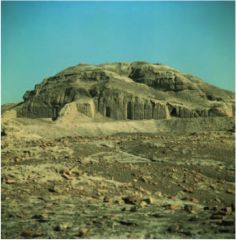
12. White Temple and its ziggurat - Uruk (modern Warka, Iraq) / Sumerian - c. 3500–3000B.C.E. - mud brick
Content -architectural piece -the ziggurat is the temple's huge base -temple sat on top (no longer remains) -dedicated to Anu -central room, called a cella -behind the cella was an altar, or "divinity room" -divinities would descend from heavens to temples -temples were sort of 'waiting rooms'
Style -made out of mud brick which was mortared together and sealed with tar -coated in a chalk whitewash -ziggurat's corners point towards the 4 directions of a compass -ziggurat is nearly 40 feet tall |
Contextual Analysis The White Temple and it's Ziggurat, as well as similar Sumerian temples, were used a middle ground between earth and the heavens. The Sumerians were the first to recognize gods existing above the human world. Temple like this were the pinnacle of the many city states at the time, dedicated to a specific god that each city state represented. The people were very concerned about looking good in the eyes of the gods and erected such huge monuments to them. Religious places such as this were reserved for a very select few, however, like the priests and attendants. Also, the ziggurat is oriented so its corners correspond with the four compass points, indicating a strong understanding of directions and the universe.
|
|
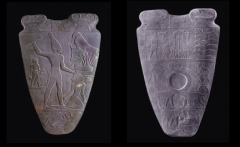
13. Palette of King Narmer - Predynastic Egypt - c. 3000–2920 B.C.E.
Content -incised stone stelle -Narrative, commemorates a historic event -Predynastic (oldest period in Egypt) -depicts some sort of procession -lots of animals -some figures are much larger than others, to signify importance -enemies' severed heads lay between their legs -similar pallets were used to grind makeup, but this one was ceremonial
Style -incised stone -"twisted perspective" is a mix between frontal and profile views of the figures, creating an unnatural, twisted look -divided into horizontal registers, which divides picture into different narrative stories
|
Contextual Analysis This stone pallet is one of the first to tell a narrative. The horizontal registers tell a story, commemorating the unification of upper and lower egypt under the warrior-king Namer. Throughout the piece, symbols from upper and lower egypt are placed together to symbolize unification. King Namer is placed centrally and appears much larger than the other figures, signifying power. He is depicted interacting with gods in animal form, emphasizing his divine power as a "god on earth". |
|
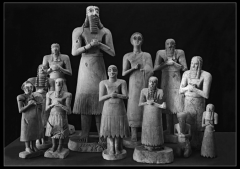
14. Statues of votive figures, from the Square Temple at Eshnunna - modern Tell Asmar, Iraq/Sumerian - c. 2700 B.C.E. - stone
Content -praying, worshipping human figures -given as offerings to gods -placed in altar area of temples
Style -subtractive carving -probably carved from cylindrical forms -huge eyes -simple forms
|
Contextual Analysis Wealthy people would pay sculptures to make them a votive figure to be placed in a temple. This system was one of the precursors to the patronism seen much later, during the Renaissance. The people thought that if a figure of them was in constant worship, then they would look good in the eyes of the gods. The bigger the figures, the more important or wealthy the person they represented was (hierarchical scale). |
|
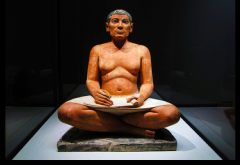
15. Seated scribe -Saqqara, Egypt / Old Kingdom, Fourth Dynasty - c. 2620–2500 B.C.E.
Content -sculpture of a seated scribe -believed to have had a wooden stylus/pencil in the past -unsure of purpose
Style -painted limestone -very naturalistic, borderline realism -highly modeled form -specific definition -subtractive method -stiff, frontal position is very typical of egyptian sculpture -meant to be seen from the front, there is no detail on the back
|
Contextual Analysis This seated figure is an exception to the ancient egyptian art norm. It depicts an actual, individualized person, which is different from lots of egyptian sculpture. In a very hierarchical society, a sculpture of a lesser-status person was very unique. Unlike the multitudes of sculptures depicting pharaohs, the artist of this piece was not concerned about projecting the subject as idealistic, but rather very naturalistic. Such artistic freedom was probably only possible in the earliest stages of the civilization, like Old Kingdom Egypt that the seated scribe was created in. |
|
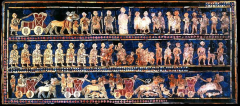
16. Standard of Ur from the Royal Tombs at Ur - modern Tell el-Muqayyar, Iraq/Sumerian - c. 2600–2400 B.C.E. - lapis lazuli, wood
Content -part of a royal funeral tomb, judging by the wealth of materials (it was also found in royal cemetery) -the front panel is a scene of peace, with the king being attended by other figures -back panel is a scene of war, with carts, horses, metal swords, soldiers, bleeding prisoners, and chariots -meant to hold something inside
Style -arranged in registers -twisted perspective -wood with inlays of lapis lazuli -arranged in registers, which tell a story (cuneiform writing)
|
Contextual Analysis This was a funerary piece that came from a royal tomb. The piece was placed in the tomb to ensure a good afterlife. It was also very important in the development of cuneiform writing, as it told a story using registers moving left to right and top to bottom. |
|
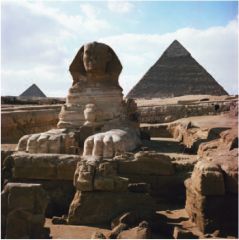
17. Great Pyramids (Menkaura, Khafre, Khufu) & Great Sphinx - Giza, Egypt / Old Kingdom Fourth Dynasty - c. 2550–2490 B.C.E. p. 87
Content -most ancient of the 7 wonders -3 pyramids for 3 different pharaohs -Giant tombs/funerary temples -rooms and passageways -reaching up towards to heavens -Khufu is the biggest pyramid, then Khafre, then Menkaure
Style -large, carved stones from massive quarries -used to be covered in a whitewashed surface -built using slave and animal labor -$ corners face cardinal directions |
Contextual Analysis Each one of the three pyramids were dedicated to one of three pharaohs. The dead body of the Pharaoh placed inside of the specific pharaoh's pyramid, as well as gifts, riches, sculptures, and other things to ensure a comfortable afterlife. The immense amount of labor and precision gone into making these pyramids emphasizes the ancient Egyptian obsession with death and the afterlife. Like Sumerian temples, the pyramids were very tall to create a meeting place between the human world and the world of the gods above. The sphinx stood as a guardian for all of the pyramids. |
|
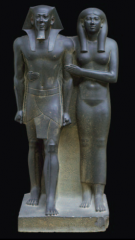
18. King Menkaura and queen -Egypt / Old Kingdom, Fourth Dynasty - c. 2490–2472B.C.E. - diorite
Content -funerary statuary -Smallest of the great pyramids is dedicated to Menkaure -wearing traditional wear
Style -4 ft 8 in tall -carved from diorite with stone tools -very hard stone -idealized to god-like standards, not realistic -standard of proportions (canon of proportions) for all statues -"Wet drapery style" of linen on women -familiar egyptian pose - stiff, frontal, one foot forward . . . authority in an image
|
Contextual Analysis This funerary piece, like much of egyptian art, highlights the importance of death. It was probably made during the life of the king to insure that he had lots to go with him into the afterlife. The king is portrayed in a highly idealized, divine matter. Artistic expression and individual artistic style was not heard of during the time period; an artist's talent depended on the ability to copy an original image and project divinity. The sculpture completely represents ideals of ancient Egypt, from perfect proportion to a stiff, frontal pose. The importance of fertility is demonstrated by the emphasized pubic triangle on the queen.
|
|

19. The Code of Hammurabi - Babylon, modern Iran / Susian - c. 1792–1750 B.C.E. - basalt
Content -communicates Haammurabi's laws -nearly 300 laws written in tiny cuneiform inscriptions -flame-shouldered god and king reacting with one another
Style -stone stele -made out of basalt -relief (subtract to raise imagery) on top -chiseled writing
|
Contextual Analysis King Haammurabi was a powerful Mesopotamian king. Babylonia flourished under his rule and his code of laws inscribed into this stone stelle. Haammurabi's code is the first instance known of civilizations establishing and enforcing laws. The relief of the king and the flame-shouldered god shows close interconnectedness between kings and god, and therefore depicts the gods approving the laws below. |
|
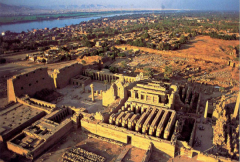
20. Temple of Amun-Re and Hypostyle Hall at Karnak - near Luxor, Egypt/ New Kingdom, 18th and 19th dynasties -temple: c. 1550 B.C.E., hall: 1250 B.C.E. - sandstone
Content -massive complex- temples, courtyards, sacred lake, sanctuary, hypostyle hall -moving into new kingdom and temple, away from pyramids -more sacred as you go in -cause way leading up to it -75-ft tall colums in hypostyle hall -obelisks made of one block of stone
Style -reliefs painted on walls (has worn away) -bilateral symmetry, precision, understanding of mathematical design (typical for new temple designs -built onto by multiple pharaohs -134 sandstone columns -post and lintel construction -first instance of clerestory windows -painted, decorated columns
|
Contextual Analysis This temple set the stage for architecture to come. Each pharaoh that ruled during the time of its creation added to the temple in a unique style and, in turn, added to the sacredness. The further back in the temple, the more sacred. On over 250 acres, the temple was home to courtyards, a sacred lake, a sanctuary, and the hypostyle hall. All of these had their own religious and spiritual purposes. |
|
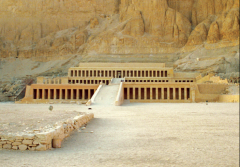
21. Mortuary temple of Hatshepsut - near Luxor, Egypt / New Kingdom, 18th dynasty - c. 1473–1458 B.C.E.
Content -new kingdom temple
Style -rock cut- cut out of limestone cliff -cause way bilaterally divides temple symetrically -tiered construction -sacred lake, lush gardens -correlation between facade and its mirroring of natural landscape -colonades....rows of columns -about 97 ft tall -statues on columns -sculptures inside are made of granite |
Contextual Analysis Hatshepsut's father, the previous pharaoh died with no direct male heirs. One of his lesser wives' son was supposed to be pharaoh next, but Hatshepsut proclaimed herself pharaoh. Throughout her entire two-decade reign, which was unusually long, she had to fight to protect her right as pharaoh. She had this mortuary temple build to prove that she deserved the title. The temple housed hundreds of sculptures of her to further emphasize her power. The first trace of a possible architect in history was found inscribed into her temple; the name 'Semnut" appears multiple times on it.
|
|

22. Akhenaton, Nefertiti, and three daughters - Egypt / New Kingdom (Amarna) - 18th Dynasty - c. 1353–1335 B.C.E.
Content -King Akhenaton, his wife Nefertiti, and their three daughters -basking in the life-giving rays of Atton, symbolized by sun disk and rays
Style -limestone -Ba relief -incised -subtractive technique -sunken relief -elongated figures, curvilinear forms -naturalistic, humanistic
|
Contextual Analysis This Ba relief is an intimate portrayal of the royal family. The Armana period had a new style, a new god, and new art. It shows humanity, something that never would have been displayed in other New Kingdom art. |
|
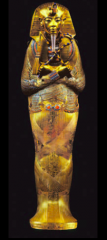
23. Tutankhamun’s tomb, intermost coffin - Egypt / New Kingdom, 18th Dynasty - c. 1323 B.C.E. - gold and precious stone
Content -housed mummy
Style -most elaborate of coffins -decorated with a variety of stones, including lapis lazuli, turquoise -inlaid designs -modeled and hammered -entirely inscribed in hieroglyphics -over a quarter of a ton of gold |
Contextual Analysis Tutankhamen ruled for ten years before dying at 18. He was a minor pharaoh, but his tomb is incredibly elaborate. It was the first intact tomb found, and gives us an insight into the Egyptian mummification and burial process. |
|

24. Last judgment of Hu-Nefer, from his tomb (page from the book of the dead) - Egypt / New Kingdom, 19th Dynasty - c. 1275 B.C.E. - Painted Papyrus
Context -painted papyrus scroll -depict a story -section from a 70-ft scroll
Style -twisted perspective -return back to traditional egyptian style after armana period |
Contextual Analysis This scroll gives us an insight into transition into afterlife and what happened there. It depicts Nubis, the god of embalming, as first step in ensuring eternal life. The scales of judgment would then weigh the dead man's heart against the feather of truth. Osiris, the king of underworld, is also shown, amongst others. |
|
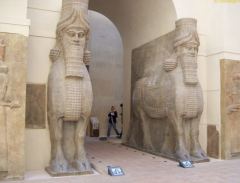
25. Lamassu from the citadel of Sargon II, DurSharrukin - modern Khorsabad, Iraq / Neo-Assyrian - c. 720–705 B.C.E.
Content -lamassu. . .mythological creature with the head of a person and the body of a bull, with wings -communicated power and authority as an intimidating presence to invaders -stood in the gates of the citadel
Style -portrayed with 5 legs ("dual perspective) -side and frontal views -limestone -over 13 ft tall |
Contextual Analysis These stood at each side of the gate to the citadel, creating an intimidating presence to intruders. They are one of many examples of art meant to portray authority. |
|
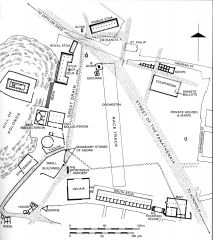
26. Athenian agora -Archaic through Hellenistic Greek - 600 B.C.E. – 150 C.E.
Content -agora = open space/square for business business -not a structure really but an idea
Style -comparative to Washington D.C. |
Contextual Analysis The Agora was a meeting place, specifically designed as a political and economic meeting place, a marketplace of ideas, and also just a marketplace for trade. It was in the center of Athens, at the convergence of the three major roads into athens, just below the acropolis. This layout influenced cities for thousands of years to come. It was sacked and destroyed multiple times and then rebuilt. |
|
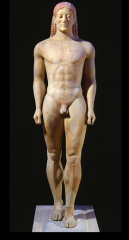
27. Anavysos Kouros - Archaic Greek - c. 530 B.C.E.
Content -nude male statue -Kouros = male statue -found in cemetery (funeral plaque) -erected at grave
Style -marble -naturalistic, humanism -stylized hair . . . typically archaic greek, geometric pattern -softly rendered, modeled . . . more fleshy and rounded -one foot forward like egyptian sculpture -life size -accurate proportions -some parts are really accurate, others, like the eyes, aren't there yet -archaic greek smile
|
Contextual Analysis A sculptor was commissioned by the family of the sculpted boy (Kroisos) to make this to be put at the boy's grave. This is one of the early examples of patronism. The inscription around the base invites visitors to stay and mourn at his tomb. |
|

28. Peplos Kore from the Acropolis - Archaic Greek - c. 530 B.C.E.
Content -Female archaic sculpture -from acropolis in athens -thought to be wearing a peplos (toga) -further research shows she was wearing multiple layers, revealing her goddess status
Style -marble -was painted -arm was free from the rest of the figure (is now broken off) -archaic greek smile -stylized geometric hair -naturalistic form -wet drapery -open eyes, slightly more detailed
|
Contextual Analysis This sculpture depicts a woman of great power or elevated social status. It is believed that the missing left arm may have been holding an offering to the gods, which would have revealed the eminent purpose of pleasing the gods. |
|
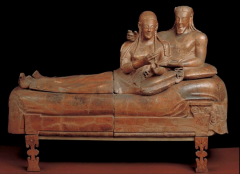
29. Sarcophagus of the Spouses - Etruscan - c. 520 B.C.E.
Content -etruscan period -box that holds a coffin -funerary statuary
Style -terra cotta . . . hard baked clay -was painted brightly -cast and fired into 4 different sections -nearly 4 ft tall, over 6 feet long -unnatural connection between body and legs -idealized
|
Contextual Analysis This sarcophagus depicts husband and wife. For the first time, elaborate coffins were not just reserved for royalty, but for wealthy commoners as well. A sarcophagus like this one would have been placed in an elaborate tomb. When found, this piece had nothing but ashes inside, suggesting a crematory process. |
|
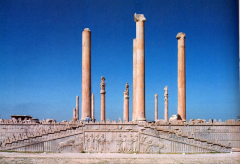
30. Audience Hall (apadana) of Darius and Xerxes - Persepolis, Iran / Persian. - c. 520–465 B.C.E.
Content -back in Iran (Persepolis) -central meeting hall -Darius and Xerxes were the successors of Syrus the Great to persian throne -combo of greek, egyptian, and mesopotamia
Style -all made of marble -combination of greek and mesopotamian ideas -staircase from both sides is mesopotamian -columns (57 ft tall) are greek -hypostyle hall -capitals of columns have a more mesopotamian style -capitals have two very mesopotamian animals put back to back to create a unique shape, with a U-shaped top, probably for the roof beams to rest on
|
Contextual Analysis As persia declined, the greek civilization was just establishing themselves. Alexander the Great conquered and raised Persepolis, but the Audience Hall wasn’t destroyed because of its strong marble base. This structure brought together styles from Egypt, Persia, and Greece. |
|
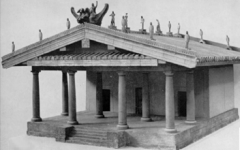
31. Temple of Minerva - Veii, near Rome, Italy / Master Sculptor Vulca - c. 510–500 B.C.E.
Content -part of a temple complex
Style -only accessible from one direction -greek pediment -classical columns -3 tiered Stylobate leading up to temple -many columns made of wood, no flutes -were painted -more use of terra cotta and clay -narrow staircase -3 separate cellas -portico . . . basically a porch |
Contextual Analysis The single, narrow front staircase leading up to this temple reflects its restriction. Unlike greek temples, which were open from all sides, roman temples were restricted to a select few (royalty). Vitruvius, a Roman man considered to be the first art historian, wrote a treatise of architecture, and began to document styles between civilizations. We can only understand temples like this one because of his writing.
|
|
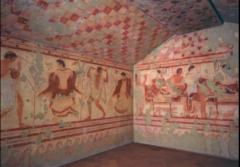
32. Tomb of the Triclinium - Tarquinia, Italy / Etruscan - c. 480–470 B.C.E.
Content -sunken areas built up with mud brick walls -part of a huge cemetery complex - necropolis -banqueting couples -men depicted with dark skin, women with light skin . . . convention -sarcophagus, items placed in tombs
Style -plastered surfaced -painted and sculpted interior -massive -completely sealed -fresco buon -pigment and plaster chemicals combined and lasted longer -twisted perspective -some of the first "illusion of death" attempts
|
Contextual Analysis
This elaborate temple, depicting banqueting couples and designs, is more in celebration of life than mourning death. |
|

33. Niobides Krater -Anonymous vase painter of Classical Greece known ast eh Niobid Painter - c. 460–450 B.C.E.
Content -form is called a krater -wheel-thrown
Style -underglaze -depiction of natural landscape to tell story . . . defining space -schematic -red clay with black glaze |
Vases like these were placed in both religious and secular buildings, depicting myths and stories. This one illustrates the myth of Niobide, a beautiful woman with lots of children. She challenged Leto, a goddess, who in turn punished her by killing all of Niobide's children. One side of the vase depicts this massacre, communicating the message to never challenge the gods. Despite all of their humanistic advances, the Greeks were still worshipping and honoring the gods.
|
|
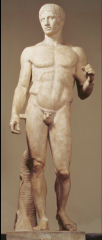
34. Doryphoros (Spear Bearer) -Polykleitos - Original 450–440 B.C.E.
Content -was holding a wooden spear -classical greece
Style -realistic depiction of humans -relaxed stance (contraposto) -still has structural supports -6'11" |
The sculptor, Polykleitos, wrote a book called "Canon" that described the rule of proportions and explored the rationale that beauty resides in harmonious numerical ratios. Doryphoros is the epitome of this philosophy. |
|
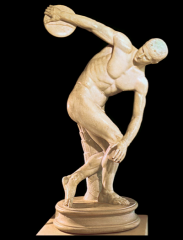
Diskobolos (Discus Thrower) - Myron / Athens, Greece / Classical Greece - c. 450 BCE
Content -discus was (and is) a sport -could be a successful athlete
Style -dynamic position . . . perfect, natural form -structural support -5'1"
|
After Polykleitos wrote "Canon" the idea of the perfect form went rampant. Diskobolos' dynamic position and perfect, natural form are an example of this. |
|
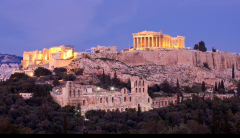
35. Acropolis, Parthenon - Athens, Greece / Iktinos and Kallikrates - c. 447–424 B.C.E.
Content -entire complex on top of hill -central Athens -parthenon = main temple -dedicated to Athena, patron goddess of Athens
Style -perfect harmony and rationalism -doric -all constructed using x=2y+1
|
Athens was the economic hub of the Mediterranean at its prime. Greeks were constantly defending their capital against invaders, so they built the acropolis on the highest point. Conveniently, the great temples could also be closer to the gods. |
|
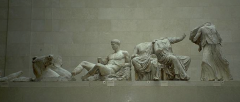
35. Helios, horses, and Dionysus (Heracles?), Acropolis - Athens, Greece / Iktinos and Kallikrates - c. 447-424 B.C.E.
Content -from the Parthenon's east pediment -depicts Athena's birth -helios' arm, head, and horses riding up -Dionysus reclining -other spectators
Style -sculpted in segments -flat-backed, to be attached to pediment -fit perfectly in tapered triangle of pediment -ionic sculpture, detailed clothing, relaxed figures
|
This is (part of) the left side of the East Pediment of the Parthenon. It illustrates Athena's birth, since the temple was dedicated to her and she is the patron goddess of Athens. |
|
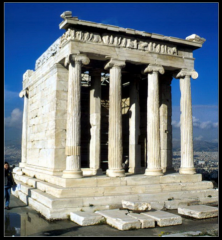
35. Temple of Athena Nike, Acropolis - Athens, Greece / Iktinos and Kallikrates - c. 447-424 B.C.E.
Content -in honor of athena and the defeat of the persians
Style -amphiprostyle -facades on one side, flat wall on other -ionic columns
|
Contextual Analysis This temple conveys Greek humanism, since it celebrates human victories alongside the gods. It is more closed off than other Greek temples, suggesting the more closed off, Roman temples. |
|

35. Victory Adjusting her Sandal, Parthenon, Acropolis - Athens, Greece / Iktinos and Kallikrates - c. 447-424 B.C.E.
Content -interior parthenon frieze -tells athena's story and the citizens victories
Style -marble -3.5 feet high -natural depiction of fabric
|
Contextual Analysis This piece celebrates the Athenian victory over the Persians. Rather than celebrating Athena, the Athenians were celebrating themselves. |
|
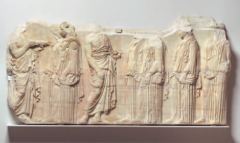
35. Plaque of the Ergastines, Parthenon, Acropolis - Athens, Greece / Iktinos and Kallikrates - c. 447-424 B.C.E.
Content -depicts festival of citizens that shows human extravagance -parthenon frieze
Style -low relief on bottom, becomes higher relief further up to create an optical illusion to the viewers below -marble |
Contextual Analysis This piece tells a story of a celebration of human extravagance. |
|

36. Grave stele of Hegeso - Attributed to Kallimachos - c. 410 B.C.E.
Content -marks grave -found all over cemetery -depicts well-to-do woman with servant/slave
Style -hierarchical scale still used -marble -was painted
|
Contextual Analysis This grave-marker reveals an intimate, humble part of middle-class life in such a public, extravagant society. Athenian women had more private lifestyle then the men, centered around the home. |
|
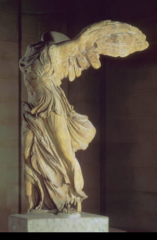
37. Winged Victory of Samothrace -Hellenistic Greek - c. 190 B.C.E.
Content -over-the-top glory -hellenistic sculpture -was designed to be perched on top of a fountain
Style -departing from realistic rationalism -full of motion -highly ornamental fabric -over 8ft tall -marble
|
Contextual Analysis This piece represents ultimate glory and the height of Hellenistic Greece. It's placement on the stern of a (statue of a ship, it also represents conquering land. |
|
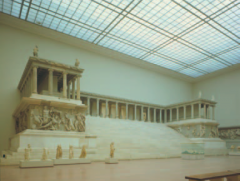
38. Great Altar of Zeus and Athena at Pergamon - Asia Minor(present-day Turkey) / Hellenistic Greek - c. 175 B.C.E.
Content -altar on top of mountain
Style -frieze located lower than temple -hellenistic sculpture -collennade -ionic columns |
Contextual Analysis The Great Altar was built towards the end of greek empire. Its elaborate friezes are all about war, domination, and victory. |
|
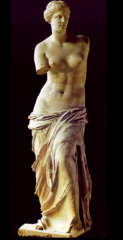
Venus de Milo -Hellenistic Greek - c. 150 BCE
Content -Aphrodite, goddess of love
Style -draping fabric -relaxed stance |
Contextual Analysis In this Hellenistic sculpture, the goddess is depicted over-erotically. Because of this, she is believed to be Aphrodite, the goddess of love, but she could have been holding something such as a bow, making her Artemis, or a spear, making her Athena.
|
|
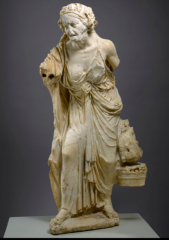
Old Market Woman - Hellenistic Greek - c. 100 BCE
Content -hellenistic sculpture -depicts old, lower-class woman -symbolic of generational conflict
Style -marble -drapery -social realism |
Contextual Analysis This sculpture depicts old women as decrepit lower class beings. This shows the respect to the elderly, or really the lack thereof. |
|

Laocoon (and his sons) - Hellenistic Greek - c. 100 BCE
Content -regular person -was a priest -agony depicted in face
Style -humanism exaggerated by agony and pain in the facial expressions |
Contextual Analysis This piece depicts agony. it shows humanism and expressionism. |
|
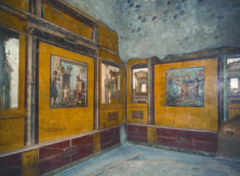
39. House of Vettii -Imperial Roman / Pompeii, Italy - c. second century B.C.E. / rebuilt c. 62 - 79 C.E.
Content -social place in addition to private rooms
Style -Fauces . . . entryway -Atrium . . . central space with natural lighting - impluvium . . .rainwater basin in the atrium naturally collects rainwater to be channeled throughout the house - Alae . . . rooms opening to atrium and street, for shops - cubicula . . . small, closed-off bedrooms opening into atrium - large central courtyard and garden surrounded by colonnade - ixion room covered in elaborated wall paintings . . . a sort of gallery - painted columns with images between creates an illusion of depth . . . one-point perspective |
Contextual Analysis Pompeii was entirely buried by a volcanic eruption, wonderfully preserving the entire town. This house, like many others, was probably a wealthy family's residence. Part of the house was private quarters, but there were rooms that opened onto the street that could be rented as storefronts. |
|

Temple of “Fortuna Virilius” - Republican Roman - c. 100 BCE
Content -traditional Republican Roman temple
Style -marble -closed sides, engaged columns -staircase on one side to portico |
Contextual Analysis Although this temple is Roman, the Greek influence is obvious. Like most Ancient Roman art, appropriation of Greek culture is evident. |
|
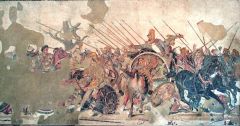
40. Alexander Mosaic from the House of Faun, Pompeii - Republican Roman - c. 100 B.C.E.
Content - mosaic - battle of Alexander the Great and Persian King Darius the III
Style - tesserae . . . the mosaic pieces, made from glass and stone - illusion of space, realistic depth |
Contextual Analysis For one of the first mosaics, the detail and depth in this is extraordinary. It is a work of propaganda, celebrating the power and authority of Alexander the Great. |
|
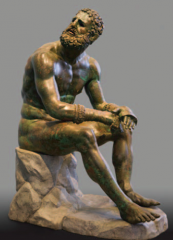
41. Seated boxer -Hellenistic Greek - c. 100 B.C.E.
Content -old, seated man
Style -bronze -patina = surface finish -realism
|
Contextual Analysis This bronze sculpture demonstrates move away from idealistic realism of the wealthy, royal, gods, and goddesses to the realistic, older, imperfect, common person. |
|
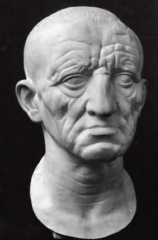
42. Head of a Roman patrician - Republican Roman - c. 75–50 B.C.E.
Content -bust -old man
Style - very realistic - not-flattering realism - full of texture -marble -eyes were painted |
Contextual Analysis When honoring deceased family members, Romans would have a bust of the deceased placed in a room of the house. They would sometimes bring the bust out and parade them through the streets, during certain celebrations.
|
|
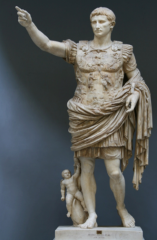
43. Augustus of Prima Porta - Imperial Roman - Early first century C.E.
Content -Classical, Imperial Rome -Augustus Caesar -baby cupid
Style -marble -between idealized and realistic |
Contextual Analysis Augustus was one of the many Caesars that ruled over Rome. They were all very powerful rulers. This sculpture amongst many others was a work of propaganda; the more beautiful the sculptures and the more there were around Rome and conquered cities, the more powerful the Caesars seemed. |
|
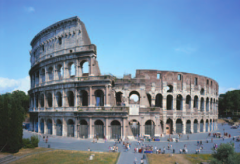
44. Colosseum (Flavian Amphitheater) - Rome, Italy / Imperial Roman - 70–80 C.E.
Content - huge stadium - 3 tiers + decorative level
Style -combo of concrete and stone -facade comprised of series of arches -the was a retractable cloth roof -wooden platform on floor -elaborate system of rooms underneath -engaged column, arch, entablature -done to create optical illusion of becoming lighter the further up -bottom layer is doric, sturdy -second is iconic, slightly more ornate and slender -third is corinthian -sculpture in each second and third story arch
|
Contextual Analysis Like so much other Roman art, the colosseum was a piece of propaganda. It was built for the people by the Flavian emperors, to gain respect and therefore honor and power. The huge building could fit between 50,000 and 80,000 people. Gladiator fights were the main attraction. |
|
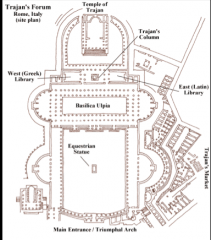
45. Forum of Trajan -Rome, Italy / Apollodorus of Damascus - Forum and markets:106–112 C.E, column completed 113 C.E.
Content -triumphal arch -courtyard with equestrian statue in center -Basilica became central meeting area for politics -temple at the back of forum -libraries
Style -basilica was surrounded by columns, covered -trajans column can be related back to obelisk |
Contextual Analysis This great complex consisted of a basilica, temple, library, and marketplace. It was a precursor to the Catholic Church layout. The column depicts battle scenes and victories of Trajan, and was meant to show glory and power of his empire.
|
|
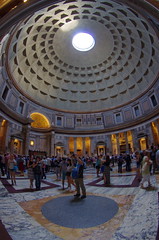
46. Pantheon - Imperial Roman - 118–125 C.E.
Content -temple to all the gods -greek/roman portico connected to domed structure
Style -concrete -multi-colored marble -columns don't have any fluting -corinthian capitals -columns = single pieces of stone, unlike cut greek columns -large enough and geometrically perfect enough to accommodate a perfect sphere -lots of perfect geometrical shapes -frieze of false windows inside -thick barrel of concrete supports dome -oculus relieves weight from top, lets in light -when it rained, the floor got wet
|
Contextual Analysis When the pantheon was built, the ground level was much lower than it is now. There were steps leading up to the portico, and there was a courtyard in front of it surrounded by a colonnade. Buildings surrounded the entire barrel part of the building, hiding its irregularity. The immense dome shows the architectural discover of how to build a dome, but also how to shape space in relationship to the viewer. The oculus brings the building into being a reflection of the heavens. |
|
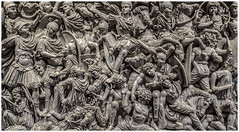
47. Ludovisi Battle Sarcophagus - Late Imperial Roman - c. 250
Content -large tomb -hero at top center
Style -marble -Romans look more noble heroic, have more ideal features, are less deeply carved . . . lighter -goths are ugly, barbaric, deeply carved . . . darker -piled one on top of another -very deep relief, some almost completely 3D forms -everything appears to be moving -figures at bottom are smaller than top . . . gives top perspective illusion -shields fram individual figures
|
Contextual Analysis By this time, it had become fashionable to be buried in a tomb rather than to be cremated. This particular sarcophagus must have been someone wealthy and powerful's coffin, because of the size and detail. It depicts a battle between the Romans and Goths. Reliefs were moving far away from classical greek relief (i.e. parthenon frieze), and were instead emphasizing the interactions between figures. The Roman empire wasn't as strong as it had been; there was lots of instability and many civil wars, and the chaotic qualities of this artistic style might mirror the chaos in the empire. The artists were less concerned with the elegance of the individual.
|

